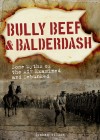Written by: Graham Wilson
Big Sky Publishing, 2012, 448 pp,
ISBN 9781921941566
Reviewed by: Justin Kelly, Department of Defence
In Bully Beef and Balderdash Graham Wilson sets out to debunk some myths surrounding the First AIF—an objective that is comprehensively achieved. The myths that Wilson addresses are varied and range from those—like the one in which the diggers were born bushmen and natural soldiers—reflective of an emerging Australian nationalism, to the more mundane examination of the pervasiveness of bully beef in the soldier’s diet.
Myths are important to societies. They form part of a cultural narrative that helps establish a shared identity based on a core set of cultural and moral values. In most cases these cultural narratives aren’t based on what we are but on what we aspire to be. If the narrative presents a set of values that are beneficial in adapting to reality they can be both an important source of cohesion within a group and an important mechanism for coping with an evolving world. The myths examined in this book are potentially important because they are held—more or less—by (at least) two social groups: the Army and the wider Australian community.
However, not all myths are created equal. Some are big myths that continue to help shape an Australian identity and still impact on the way we approach the world while others, about the fighting-est chaplain in the AIF or whether Edward Gaby VC was photographed posthumously, are of specialist or local interest only. However, Wilson isn’t selective; he has apparently gathered all the myths surrounding the First AIF and subjected them equally to forensic examination. Whether or not this completeness adds to the worth of the book is moot. None of the myths is examined for its importance or continuing impact—if they had been a different book might have emerged. What we have is essentially a series of essays, each of which addresses a single myth and each of which is structured along these lines: the myth, its origins, and then the facts that refute it.
In assembling the refutation Wilson presents tightly structured arguments supported by extensive examination of primary sources. He is not shy about laboring a point and in a number of the chapters this reviewer was absolutely convinced by the half-way point. Generally, only the most committed and fervent myth-holders will be able to sustain their beliefs to the end of any of the chapters.
However, in the last chapter—examining the charge at Beersheba—Wilson is at risk of over-extending himself. Suggesting that the charge represented a ‘last desperate throw of the dice by Chauvel to make up for his bungling of the Desert Mounted Corps’ part in Third Gaza and an effort to save his reputation’, Wilson ventures, for the first time, into the world of tactics. This is a different kind of history to that contained in the previous thirteen chapters. In it the types of questions are not just ‘what happened’ but what were the options available, what risks were perceived at each level of command, how did one regiment differ from another in morale, aggression or competence—in short, rather than converging onto a single truth, historical examination of tactics needs to open up consideration of the vast array of potentialities and only then, possibly, arrive at a ‘on the balance of probabilities’ assessment of the most favourable course of action. In the four pages of text Wilson commits to the task of deconstructing Chauvel’s decisions there is insufficient space to do this kind of analysis and in the end, Wilson bases his refutation on the availability, and rejection by Chauvel, of a single alternative course of action. In the rest of the chapter, which goes on to show that the claim that Beersheeba was the last great cavalry charge is bunkum, Wilson returns to his strong suit and makes his points with aplomb.
So what is in this book for the professional soldier? Really, the importance is in the subtext rather than in the text. What the book indirectly reinforces is the complexity of warfare, the importance of training and organization, and huge demands for solid, detailed, grinding staff-work. Bully Beef and Balderdash is a diverting light read—ideal for the staff college student on a beach holiday.


